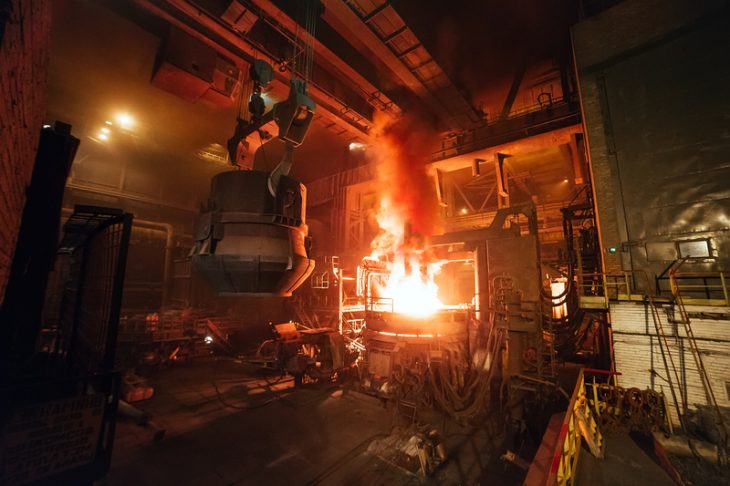Romania’s steel sector is responsible for approximately 6.3% of national carbon dioxide emissions, and in these conditions the decarbonization of primary steel production remains one of the most pressing challenges for the future of Romanian industry, according to a report published by the Energy Policy Group (EPG).
“Although Romania’s steel sector has reduced its activity compared to 1990, it still contributes significantly to the national economy and the workforce, generating approximately 6.3% of national carbon dioxide (CO2) emissions. These contributions are dominated by Liberty Galati, the only primary steel producer still active in Romania, with almost 5,000 employees and emissions of 4.39 million tons (Mt) of CO2 in 2021 (5.9% of total CO2 emissions at national level),” it is stated in the EPG report on the decarbonization plan of Liberty Galati, quoted by Agerpres.
According to the quoted source, conventional primary steel production, a high-carbon process, is under increasing pressure to transform in the context of the EU’s climate commitments: the phasing out of free allowances under the trading system of gas certificates with greenhouse effect (EU ETS), future regulations on sustainable products, and the rising price of carbon.
These challenges are insufficiently recognized in Romania’s industrial and climate strategies: the Long-Term Strategy, the draft of the Integrated National Plan for Energy and Climate and the draft of Romania’s Industrial Strategy 2023-2027 do not sufficiently consider the magnitude of the challenge generated by the transformation of the steel sector and the opportunities brought by the production of green steel, the report states.
Liberty Galati has publicly announced its decarbonisation plan involving the replacement of the BF-BOF process with DRI-EAF, using methane gas as a DRI reducing agent in a transition phase, to be replaced by 100% renewable hydrogen by 2030. This plan (the “Greensteel” plan) will be implemented in parallel with a doubling of steel production, reaching 4.1 Mt of liquid steel by 2030.
According to EPG estimates, implementation of the Greensteel plan could reduce emissions from liquid steel production (which generates 81% of emissions from primary steel production) by 93% by 2030, i.e. a reduction of 3.26 Mt CO2 per year. This transformation could provide a significant competitive advantage to the company as a supplier of green steel, helping to supply a growing demand for green steel, especially from the automotive industry. The transformation could also launch a local green economy, including renewable electricity and hydrogen production, to meet the 160,000 ton/year demand of the future DRI-EAF process at Liberty Galati.
“For the deep transformation of the steel plant according to the Greensteel plan, a massive mobilization is required for the installation of renewable energy capacities, investments in the production of renewable hydrogen and ensuring a reliable supply of scrap metal. The electricity consumption of the liquid steel production process will increase ten times, and reaching the emissions targets of the Greensteel plan, even if renewable hydrogen is not domestically produced, will only be possible if Romania’s electricity mix halves its carbon emission intensity. If hydrogen is domestically produced, additional renewable energy capacities of 6.35 GW, 136% of the total installed capacity of solar and wind power nationally, will be needed in January 2024,” the report quoted said.
Liberty Galati’s demand for renewable hydrogen in 2030 will be higher than the consumption of the entire economy foreseen in the National Strategy for Hydrogen, and the company’s scrap metal consumption will increase four times, reaching a requirement equal to 80% of current iron exports old of Romania, claim EPG experts.
Also, the investment cost of the technological transformation, as well as the operational cost for the production of renewable hydrogen, will require support from the state, directly as well as indirectly, to increase investment certainty.
“In order for the Romanian steel sector to become the spearhead of the industrial transformation and the revival of the competitiveness of the manufacturing industry, it is necessary to develop concrete and detailed transformation plans, which are synchronized with the national industrial and climate strategies,” the report states.
According to the cited source, well-targeted and intelligently sized public funding, through instruments such as those to support the market for green steel such as Green Public Procurement and Contracts for Carbon Differences (CCfDs) is essential to support high investment costs, especially in the next decade when allocations free for industrial operators will be phased out.
“Infrastructure development must also be planned: the installation of renewable electricity and electrolyser capacities, the modernization and consolidation of the national energy system, and the construction of hydrogen transport infrastructure. New raw material supply chains and above all a rethink of scrap metal exports from Romania. All these actions will be necessary regardless of the decarbonization trajectory chosen by Liberty Galati and require a change in approach to the issue of industrial transformation on the part of the national authorities,” the Energy Policy Group specialists also said.
